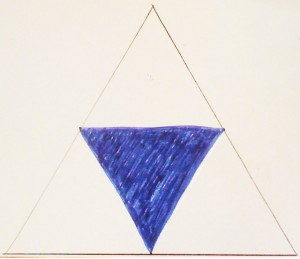
In an in-service course for teachers at “mellomtrinnet” (pupils age 9-13), I gave the participants the following exercise in GeoGebra: draw a triangle. Find the midpoint of each side of the triangle. Use these three midpoints as corners for a new triangle.
The somewhat interesting fact is that the new triangle will have the same shape as the original one. This can of course be easily proved, but at this level, the pupils could also just explore the triangles in GeoGebra and see that it seems right.
I then asked the teachers what else they could use this quite simple figure for. Are other mathematical concepts involved? Indeed, there are lots of things to be found:
You can find all the angles of the original triangle repeated several times inside this figure. In particular, you can find them repeated next to each other, so that you see that the three angles taken together is 180 degrees.
You can observe that the original triangle has now been divided into four congruent triangles. Thus, dividing each of the original sides into two, has lead to dividing the area into four. This could be a useful reminder for the pupils. If you also discuss the (omkrets) of each of the new triangles, you will find that they are half of the original (omkrets). Again: a useful reminder of the difference in the behaviour of area and (omkrets).
Of course, there are also parallel lines involved.
If you repeat the operation (that is, find the midpoints of the sides of the new triangle and create yet another triangle using these midpoints as corners) several times, you will get in touch with the idea of fractals. Moreover, you can keep discussing the lengths and areas of each triangle. (Repeating this operation many, many times is very simple in GeoGebra if you create a new tool for this job.)
Thus, by means of a very simple drawing, many important concepts from the curriculum can be discussed. Of course, formal proofs can also be introduced if the teacher wishes.
Do you see other interesting aspects of this drawing – or want to draw my attention to similar examples – please leave a comment below.




No comments:
Post a Comment